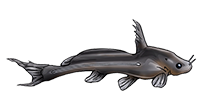Thank you golddty and CharlieM9.

Going back to the question at the heart of this thread, I have received one other opinion (at corydorasworld.com) that these are C141, not
pulcher (I will leave names out of this to avoid creating conflicts; but needless to say, since I'm hoping these are C141, I'm happy to receive that opinion).
None-the-less, I feel like there is a lot to be worked out between these two catfish. With all the color variations evident in the photos in the CLOGs of both
and
, it's difficult for me to identify specific features that definitively separate these two. But so far, I have a few ideas:
- pulcher appears to grow a much more prominent (taller and thicker) white dorsal spine (sort of like ), compared to C141;
- in pulcher, there is more (somewhat diffuse) black coloration behind the operculum, just anterior to the upper and middle horizontal stripes;
- pulcher appears to have more black pigment along the dorsal margin of its body, posterior to the dorsal fin;
- pulcher seems to have its horizontal black stripes separated by wider white/silver/tan (whatever the pale background body color is) lines, whereas in C141 the black lines are closer together;
- related to (4), in C141 all three horizontal stripes reach the tail through the caudal peduncle, whereas in pulcher the upper horizontal stripe terminates before the caudal peduncle by blending into the black coloration along the dorsal body margin at or before the anterior edge of the adipose fin, and the lower strip terminates before the caudal peduncle by blending into the ventral margin at the anal fin; and finally
- also related to (4), in order to allow room for the more widely separated black lines, pulcher appears to have a taller body dorsoventrally (again, sort of like robustus), whereas C141 has a body that doesn't grow so high (this may be an optical illusion created by the wide pale stripes/areas on the flanks of pulcher, and may not be true at all).
I borrowed a gif artwork from Planetcatfish.com (
http://www.planetcatfish.com/common/fam ... amily_id=1) and tried to characterize visually the differences I described above; the picture is attached. Also, I looked up the original description of
pulcher by Isbrücker & Nijssen (
http://www.repository.naturalis.nl/document/548527), to confirm that the features I've highlighted about
pulcher are accurate relative to the species holotype/paratype. The features I list regarding pulcher are mentioned in the original description (except for the tallness of the body), so these features do describe
pulcher. But since C141 is not a "formally described" species, the problem is that I don't know what does and what does not "unofficially" fit within our understanding of what C141 looks like.
With the exception of the dorsal spine, all of these features seem rather variable in the photos of both cats, and there is overlap. That's why I'm wondering if C141 might be the same as
pulcher. Conversely, if C141 does represent a unique and undescribed new species, how likely is it that what people are currently calling C141 is actually a mix of real C141 and some specimens of
pulcher (and thus explaining the two different C141 color patterns mentioned in an earlier post in this thread)?
Feedback?
Thanks, Eric
P.S., After going through all of this analysis, I find it very odd that websites and stores seem to find C141 confused with
. Frankly, I find no grounds for that confusion; IMHO,
pulcher and
schwartzi are far more similar to C141 than is
ornatus (although the striping pattern is wrong in
schwartzi), and the presence of a white dorsal spine in C141 is a dead giveaway that it's not
ornatus. Does the confusion occur because C141 is more likely to be imported with
ornatus? And if so, is that mixing occurring at the wholesaler/exporter, or at the site of capture? And if it's at the site of capture, does either
schwartzi or
pulcher co-occur with
ornatus in nature? Does anybody with collection experience know the answer to these questions?
Thank you so much, and I apologize for the length of this post (and the whole thread). Cheers, Eric













